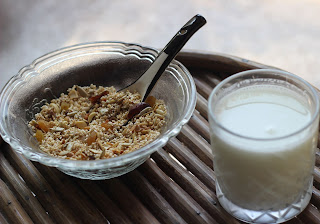Small Loaf Wholly Wholewheat Bread
I started my bread
experiments with maida but very soon began to substitute it with wholewheat.
Now the Indian atta is not the same as what sells as wholewheat flour in USA
and Europe. I believe the grinding process is different making atta coarser,
but it is what is easily available here. I hit the solution when I discovered
organic atta flour. It rises beautifully and has a nutty flavour (especially
enhanced if you add just a bit of honey to the mix) and goes well with all
kinds of egg, jams and spreads. Wholewheat bread needs a bit more yeast, liquid
and rise time as compared to maida or an atta-maida flour mix.
This particular recipe
emerges from my attempt to bake a small loaf for a single person household. The
thing to know about bread is that it has core ingredients and beyond them,
there are options galore. The core to bread comprises of flour, yeast, water
and salt. Yes, that’s it. And of course, time. Not the actual time spent in the
kitchen, that is about 15 minutes max. But time spent waiting and being around
to check in on the progress. The key ingredient is, I must caution, yeast. You
have to get good quality yeast. My early bread experiments were full blown
disasters because the most commonly available yeast would just not budge (and I
didn’t know that it wasn’t budging 😊). The brand I recommend unhesitatingly is Dr
Oetkar, but there are other options around.
I am sharing my go-to
recipe. Multiple add-ons are possible- seeds, cheese, herbs, spices, nuts, dry
fruits. They are to be added before you start kneading. You can also substitute
oil with softened butter or ghee. I am planning to crack an egg into the
mixture and make pav/rolls. Will update!
So, to the recipe now.
Ingredients:
Organic Whole-wheat
Atta: 200 gms
(Alternatively you can substitute 1/4th of the flour with Maida. Also, you can work with
rough measures so 2 measures of your standard cup, assuming the standard is
between 75-100 gms)
Yeast: 1.25 teaspoons
Water: 100 ml and Milk:
100 ml or Water 200 ml
Oil: 2 teaspoons, and
0.5 teaspoon to film the dough.
Honey: 1.5 teaspoons
Salt: 1.25 teaspoons
Method:
1.
Warm the
water or milk and water together. The temperature should be such that when you dip your
finger in, it can stay comfortably without feeling hot. Remember, it shouldn’t
be cold either, then the yeast wont get activated.
2.
While one
is still getting a hang of bread baking, it is wise to proof the yeast. For
this, warm the water separately, pour on your mixing dish, add the yeast,
gently mix, cover and let it stay for ten-fifteen minutes. If you can see the mixture
foaming and bubbles forming, your yeast is good to go. Once you get more
confident you can skip proofing and go straight to step 3.
3.
In a large
mixing bowl, add all the ingredients and mix. Pour over the water or water-milk mixture
and knead with a hand-mixer or by hand for about 10 minutes. If you are using a
hand mixer, start with the lower speed and gradually increase to the higher
one. The dough is done when it is a bit shaggy but can be shaped into a ball.
4.
Shape the
dough into a rough ball, film with a bit of oil and then cover the bowl with a
cloth or a lid (or both!) and leave it alone for an hour and half at least.
Unless it is 40 degrees in the kitchen as during Indian summers, then the bread
would be good to go in an hour.
5.
Meanwhile,
get the baking tin ready by either covering it with parchment paper or coating
it first with oil and then flour.
6.
The dough
would have risen to double its size. Now coat your kitchen counter or the marble
chakla (we use to roll out rotis) with flour, knead the dough for a few minutes
and shape it as per preference. Make sure the edges are tucked in and the
surface is tight. Put it into the baking tin,
cover with kitchen paper and let it rise for half an hour. If it is a
smaller tin, then the dough will spread out to take its shape. If it is a
larger tin then it will expand in the shape you have given it, whether it is a
rectangle or a round shape.
7.
15 minutes
after leaving the dough for a second rise, preheat your oven at 220 degree
Celsius.
8.
After the
stipulated half an hour, if the bread
has visibly risen, then brush the
surface with water and make small incisions on it. You can go all artistic with
the incisions or make a simple cut in the middle from one end of the loaf to
another.
9.
Lower the
oven temperature to 190 degree Celsius, put in the tin and bake for 35-40
minutes.
10.
The bread
is done when you hear a hollow sound on tapping its crust. If you want a
browner crust, bake a bit more.
11.
Breathe in
the smell of fresh baked bread and smile.




Comments
Post a Comment